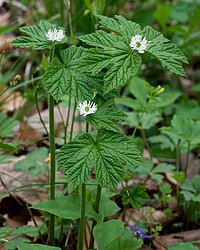
The effects of clonal integration on the responses of plant species to habitat loss and habitat fragmentation
Sign Up to like & getrecommendations! Published in 2018 at "Ecological Modelling"
DOI: 10.1016/j.ecolmodel.2018.06.016
Abstract: Exploring the mechanism of plant species persistence in fragmented landscapes has already become a major issue in spatial ecology. Most of previous models predicted that habitat loss and fragmentation negatively impact plant species persistence, while… read more here.
Keywords: plant species; clonal integration; habitat loss; habitat fragmentation ... See more keywords

Clonal integration facilitates spread of Paspalum paspaloides from terrestrial to cadmium-contaminated aquatic habitats.
Sign Up to like & getrecommendations! Published in 2017 at "Plant biology"
DOI: 10.1111/plb.12617
Abstract: Cadmium (Cd) is a hazardous environmental pollutant with high toxicity to plants, which has been detected in many wetlands. Clonal integration (resource translocation) between connected ramets of clonal plants can increase their tolerance to stress.… read more here.
Keywords: apical ramets; integration; connection; clonal integration ... See more keywords

Effects of clonal integration on the proximal and distal ramets of Cynodon dactylon under shade stress
Sign Up to like & getrecommendations! Published in 2018 at "Brazilian Archives of Biology and Technology"
DOI: 10.1590/1678-4324-2018160475
Abstract: In a pot experiment, clonal ramets of Cynodon dactylon, a stolon herbaceous plant, were treated with heterogeneous lighting. Proximal ramets (elder ramets) were subjected to shade stress at three different degrees, and stolons between proximal… read more here.
Keywords: distal ramets; ramets cynodon; clonal integration; shade stress ... See more keywords

Clonal integration benefits an invader in heterogeneous environments with reciprocal patchiness of resources, but not its native congener
Sign Up to like & getrecommendations! Published in 2022 at "Frontiers in Plant Science"
DOI: 10.3389/fpls.2022.1080674
Abstract: Many of the world’s most invasive plants are clonal, and clonal functional traits are suggested to contribute to their invasiveness. Clonal integration is one of the most important clonal functional traits, but it is still… read more here.
Keywords: patchiness resources; integration; reciprocal patchiness; environments reciprocal ... See more keywords

Heterogeneous Nitrogen Supply With High Frequency and Ramet Damage Increases the Benefits of Clonal Integration in Invasive Hydrocotyle vulgaris
Sign Up to like & getrecommendations! Published in 2022 at "Frontiers in Plant Science"
DOI: 10.3389/fpls.2022.825492
Abstract: Nitrogen (N) deposition significantly affects the growth and the function of invasive clonal plants. However, the effects of heterogeneous N supply with different frequencies on the growth and the potential contribution of clonal integration in… read more here.
Keywords: high frequency; ramet damage; damage; supply ... See more keywords